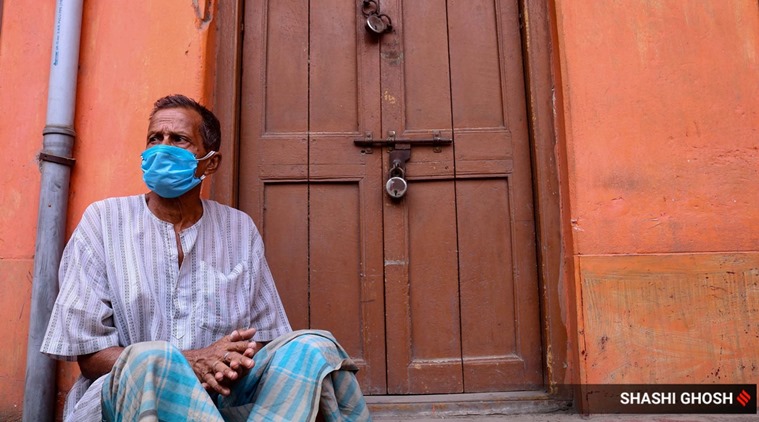 An old man waits to open his grocery shop amid lockdown restrictions in Kolkata (Express Photo Shashi Ghosh)
An old man waits to open his grocery shop amid lockdown restrictions in Kolkata (Express Photo Shashi Ghosh)
“Are you keeping records of the way your hearts and minds are reacting to this strange new way of living?” In a letter to his students, the American novelist George Saunders urges them to pay attention to the world and themselves, as it lurches to a bewildering halt. To see, as writers and artistes can, the invisible inches by which we rearrange the deepest parts of our lives, how we get turned into history’s playthings. So, what are the stories we will tell of this pandemic?
By freezing up the world, the novel coronavirus has made us look at it anew. Like the sudden views of the Himalayas from Saharanpur or Jalandhar, we unfog our eyes and look at the architecture of our lives. Working from home, we now experience the mountain of work at home — never considered real work, because women can be paid a pittance (or not) to do it. The cult of productivity is suddenly shamefaced.
In this pause, we put on music, watch films, see children calm themselves as they paint — the arts and artists stepping in to heal, as we wait to emerge on the other side.
Not blessed with a writer’s serendipity, I can see only as far as ghostly, emptied streets. Out on a grocery run, my eyes seek out strangers, a pang of joy at the sight of fellow humans — after weeks of lockdown, panic has given way to this hunger. We live and think surrounded by the hum of other voices; we swim, especially in this country of a billion, in a river of people. This stifling unease we have been lugging around, locked in homes we are lucky to possess, is also a longing for others. For the lives of others, their gaze that holds us in shape, the public sphere that gives the private corner meaning. It reminds me of a question once posed to Ramana Maharishi. “How do we treat others?” His reply: “There are no others.”
The coronavirus has underlined this interconnected-ness of human life. It has also dangled a test: Do we choose solidarity or suspicion? In India, the muscle memory of caste superiority has kicked in, making it easier to suspect, police and distance the less-privileged. History will also remember this as a time when the Hindutva project of turning Muslim citizens into second-class subjects, and re-imagining them as uber-outcastes, did not pause for a public health emergency but gathered pace. What will emerge on the other side of this animus?
It wasn’t just lofty mountain ranges that swam into view in this upheaval. Gazing down from dizzying heights, several drone cameras brought us visuals of empty metropolises, drained of its people, noise and squalor. It was a fantasy, like all top-down views tend to be — especially for the middle class, which had retreated into apartment complexes and behind N95 masks. On the ground, the invisibles had emerged, making but one claim on the city they had helped build with their labour: Send us home. Since the 1990s, the dream of an aspiring metropolitan India has been a dazzling, exponential graph, making even our cinema turn away from the tales of the poor. But the countless images of men and women, abandoned by the state, walking hundreds of kilometres away from the hostile city, hiding themselves in trucks and cement mixers, following the compass of rail tracks to a cruel death is the most damning evidence of inequality to confront us since liberalisation. Who will tell the stories of this pandemic? For, which stories are told, and which matter, is a function of power.
It is that power that has made the city’s voice heard over the village and the kasba, the national over the provincial. A hobbled, angry state speaks for the poor but will not factor their needs while planning a national shutdown. It is also the privilege of people like us that allows us to see migrant workers only as benighted victims.
When history accounts for this great exodus, it will see the uncommon resilience, dignity and agency of lakhs of workers, who chose a path — as all heroic humans do in the face of great adversity — even if it leads to the unknown. Will we listen to these storytellers of the pandemic?
amrita.dutta@expressindia.com